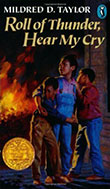Roll of Thunder, Hear My Cry Q&A

Use these questions with children 10 to 13 years old to discuss the following economic concepts in Roll of Thunder, Hear My Cry: mortgage, note, and collateral.
View all of our Parent Q&A resources.
Book written by Mildred D. Taylor (ISBN: 0-14-038451-0).
Braille and Talking Book versions are available via the National Library Service for the Blind and Print Disabled. Library of Congress catalogue numbers are provided for accessible versions. The books can be accessed through BARD (Braille and Audio Reading Download). The book is available in Braille LCCN 97992624 and Talking Book LCCN 94974123.
Questions:
1. What is sharecropping?
Sharecropping is a system of agricultural production where land owners allow tenant farmers to plant, tend, and harvest the crops the tenants plant. In return, the tenants are paid for their labor with living quarters and a share of the crops produced.
2. The Wallace store was a company store where tenants from the Granger, Montier, and Harrison plantations and others shopped. What did it mean when these landowners signed for their tenants?
Sharecroppers were only paid once a year at harvest time after all their debts were settled at the store. The landowners signed a paper guaranteeing the storeowner payment for the supplies purchased.
3. Collateral is something of value a lender is able to keep if a borrower fails to repay a loan. Why could tenant farmers use their future crops as collateral for purchasing goods at the Wallace store but not at other stores?
The landowners Granger, Montier, and Harrison only agreed to sign and back the sharecroppers' portion of the crops at that store. They would not sign an agreement to extend credit at any other store.
4. Why did sharecroppers sometimes owe more than their share of the crop to the company store?
Prices were set by the company store and the land owners (Granger, Montier, and Harrison) owned the store. The Wallaces only managed the store.
5. Why didn't the Averys and other sharecroppers have cash to shop where they wanted?
They were only paid after harvest once a year. If they did get any cash, it often did not last long. They relied on credit from the company store.
6. What collateral did the Logan family have that the sharecroppers did not?
The Logan family owned 400 acres of land.
7. A mortgage note is a written note promising to repay a specific sum of money loaned plus interest at a specified rate and length of time or the land purchased with the note can be sold to pay the bank. The Logans used their 200 acres of land as collateral to get a loan from the bank and signed a mortgage note. What did the Logans buy?
The Logans purchased an additional 200 acres from Mr. Jamison.
8. What did it mean for the Logan family when the bank "called up the note" on their land?
They were required to pay the entire remaining amount of the loan immediately or the land would be sold to pay the bank.
9. How did Uncle Hammer get the money to pay the mortgage note?
Uncle Hammer sold his Packard car and borrowed some money to get the full amount needed to pay off the mortgage note on the land.
---
If you have difficulty accessing this content due to a disability, please contact us at 314-444-4662 or economiceducation@stls.frb.org.

